All Exams >
Grade 9 >
AP Physics 2 >
All Questions
All questions of Moving Charges and Magnetism for Grade 9 Exam
If we double the radius of a current carrying coil keeping the current unchanged. what happens to the magnetic field at its Centre?- a)halved
- b)doubled
- c)remains unchanged
- d)becomes four times
Correct answer is option 'A'. Can you explain this answer?
If we double the radius of a current carrying coil keeping the current unchanged. what happens to the magnetic field at its Centre?
a)
halved
b)
doubled
c)
remains unchanged
d)
becomes four times

|
Ciel Knowledge answered |
As,
B=μonI/2a
a ->radius
B ∝1/a
B1/B2=a2/a1
B1=2B2
B2=(1/2) x B1,
Magnetic field is halved.
B=μonI/2a
a ->radius
B ∝1/a
B1/B2=a2/a1
B1=2B2
B2=(1/2) x B1,
Magnetic field is halved.
Two thin long parallel wires separated by a distance b are carrying a current i ampere each. The magnitude of the force per unit length exerted by one wire on the other is- a)

- b)

- c)

- d)

Correct answer is option 'D'. Can you explain this answer?
Two thin long parallel wires separated by a distance b are carrying a current i ampere each. The magnitude of the force per unit length exerted by one wire on the other is
a)
b)
c)
d)

|
EduRev Humanities answered |
Given, i1=i2=i
∴F=μ0i2l/2πb
Hence, force per unit length is F=μ0i2/2πb
∴F=μ0i2l/2πb
Hence, force per unit length is F=μ0i2/2πb
An electron and proton enter a magnetic field with equal velocities. Which one of them experiences a greater force?- a)electron
- b)proton
- c)Both experience same magnitude of force
- d)No prediction can be made.
Correct answer is option 'C'. Can you explain this answer?
An electron and proton enter a magnetic field with equal velocities. Which one of them experiences a greater force?
a)
electron
b)
proton
c)
Both experience same magnitude of force
d)
No prediction can be made.

|
Divey Sethi answered |
As charges and velocities are same
F=q(V×B)
So having the same magnitude of charge and same velocity, they'll experience the same magnitude of force.
F=q(V×B)
So having the same magnitude of charge and same velocity, they'll experience the same magnitude of force.
Two concentric coils carry the same current in opposite directions. The diameter of the inner coil is half that of the outer coil. If the magnetic field produced by the outer coil at the common centre are 1 T, the net field at the centre is
- a)4T
- b)2T
- c)1T
- d)3T
Correct answer is option 'C'. Can you explain this answer?
Two concentric coils carry the same current in opposite directions. The diameter of the inner coil is half that of the outer coil. If the magnetic field produced by the outer coil at the common centre are 1 T, the net field at the centre is
a)
4T
b)
2T
c)
1T
d)
3T
|
|
Krishna Iyer answered |
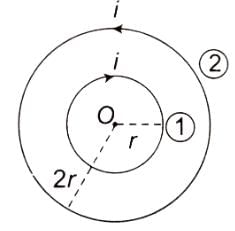
The magnetic field produced by a current-carrying coil at its center is given by the formula,
B = μ0 * (N*I/R),
where,
B is the magnetic field,
μ0 is the permeability of free space,
N is the number of turns in the coil,
I is the current through the coil, and
R is the radius of the coil.
In this case, both the coils carry the same current but in opposite directions. So, the fields produced by them will be in opposite directions. Also, the diameter of the inner coil is half that of the outer coil. Thus, the radius of the inner coil will be half that of the outer coil.
Therefore, the field at the center due to the inner coil will be double that due to the outer coil (because the magnetic field is inversely proportional to the radius).
Since the fields are in opposite directions, the net field at the center will be the difference between the two fields. That is, 2B (due to the inner coil) - B (due to the outer coil) = B.
So, if the field due to the outer coil is 1 T (Tesla), the net field at the center will also be 1 T.
Hence, the correct answer is 3. 1T.
The magnetic field due to circular coil of 200 turns of diameter 0.1m carrying a current of 5A at a point on the axis of the coil at a distance 0.15m from the center of the coil will be- a)

- b)

- c)

- d)

Correct answer is option 'D'. Can you explain this answer?
The magnetic field due to circular coil of 200 turns of diameter 0.1m carrying a current of 5A at a point on the axis of the coil at a distance 0.15m from the center of the coil will be
a)
b)
c)
d)
|
|
Krishna Iyer answered |
B=μ02πnIa2/4π (a2+x2)3/2
=10−7×2×(22/7)×200×5×(0⋅1/2)2/ [(0⋅1/2)2+(0⋅15)2]3/2
=39.74x10-5
=10−7×2×(22/7)×200×5×(0⋅1/2)2/ [(0⋅1/2)2+(0⋅15)2]3/2
=39.74x10-5
Wire of length l, carries a steady current I. It is bent first to form a circular coil of one turn. The same wire of same length is now bent more sharply to give two loops of smaller radius the magnetic field at the centre caused by the same current is- a)one third of its initial value
- b)nine times of its initial value
- c)four times of its initial value
- d)unaltered
Correct answer is option 'C'. Can you explain this answer?
Wire of length l, carries a steady current I. It is bent first to form a circular coil of one turn. The same wire of same length is now bent more sharply to give two loops of smaller radius the magnetic field at the centre caused by the same current is
a)
one third of its initial value
b)
nine times of its initial value
c)
four times of its initial value
d)
unaltered
|
|
Om Desai answered |
Let the radii be r1 and r2 respectively.
Since there are two turns of radius r2, r1=2r2
Magnetic field B at the centre of the coil of radius r1 B1=μoi/2r1=μoi/4r2
Magnetic field B at the center of the coil of radius r2 B2=2×μoi/2r2
∴ B2/B1 =(2× μoi/2r2)/(μoi /4r2) =4
Hence the answer is option C, four times its initial value.
Since there are two turns of radius r2, r1=2r2
Magnetic field B at the centre of the coil of radius r1 B1=μoi/2r1=μoi/4r2
Magnetic field B at the center of the coil of radius r2 B2=2×μoi/2r2
∴ B2/B1 =(2× μoi/2r2)/(μoi /4r2) =4
Hence the answer is option C, four times its initial value.
A 2 cm long copper wire having mass of 6 gm, dips in to two mercury pools to form a complete circuit. The wire is placed between the poles of a magnet which causes a field strength of 0.3 T. Find the initial upward acceleration of copper wire after 100 A of current is passed through the wire (g = 10 m/s2)- a)1 m/s2
- b)10 m/s2
- c)100 m/s2
- d)90 m/s2
Correct answer is option 'D'. Can you explain this answer?
A 2 cm long copper wire having mass of 6 gm, dips in to two mercury pools to form a complete circuit. The wire is placed between the poles of a magnet which causes a field strength of 0.3 T. Find the initial upward acceleration of copper wire after 100 A of current is passed through the wire (g = 10 m/s2)
a)
1 m/s2
b)
10 m/s2
c)
100 m/s2
d)
90 m/s2
|
|
Hansa Sharma answered |
ma=Bil−mg
a=0.3×100×2×10−2−10×6×10−3/ m
a= 0.6−0.06/6×10−3
=100−10
=90ms−2
a=0.3×100×2×10−2−10×6×10−3/ m
a= 0.6−0.06/6×10−3
=100−10
=90ms−2
A circular coil of radius r carries current I. The magnetic field at its center is B. at what distance from the center on the axis of the coil magnetic field will be B/8- a)√3R
- b)√2R
- c)2R
- d)3R
Correct answer is option 'A'. Can you explain this answer?
A circular coil of radius r carries current I. The magnetic field at its center is B. at what distance from the center on the axis of the coil magnetic field will be B/8
a)
√3R
b)
√2R
c)
2R
d)
3R

|
Shilpa Saha answered |
As you know that magnetic field at point on the axis of current carrying ring is


where x is the point on the axis of ring, R is the radius of ring , i is the current carrying on ring and N is the number of turns .
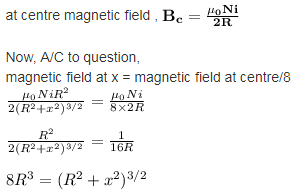
This is possible only when x = +-√3R
Hence, √3R distance from the centre magnetic field is equal to magnetic field at centre .
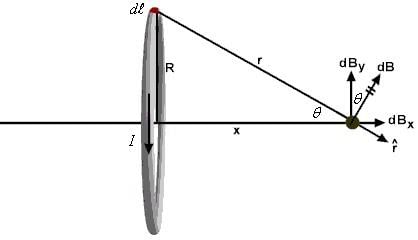

A rectangular loop carrying a current I is situated near a long straight wire such that the wire is parallel to the one of the sides of the loop and is in a plane of the loop. If a steady current I is established in wire as shown in figure, the loop will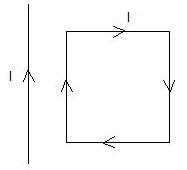
- a)move away from the wire or towards right
- b)remain stationary
- c)rotate about an axis parallel to the wire
- d)move towards the wire
Correct answer is option 'D'. Can you explain this answer?
A rectangular loop carrying a current I is situated near a long straight wire such that the wire is parallel to the one of the sides of the loop and is in a plane of the loop. If a steady current I is established in wire as shown in figure, the loop will
a)
move away from the wire or towards right
b)
remain stationary
c)
rotate about an axis parallel to the wire
d)
move towards the wire

|
Top Rankers answered |
The long straight wire and side AB carry current in the same direction, hence will attract each other.
The long straight wire and side CD carry current in the opposite direction, hence will repel each other.
Force on side BC will be equal and opposite to force on side DA.
Since CD is farther from the wire than AB, the force of attraction on AB will exceed the force of repulsion on CD.
Hence, there will be a net force of attraction on the loop ABCD and it will move towards the wire.
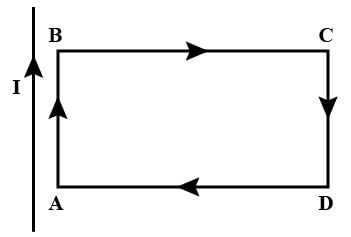
The long straight wire and side CD carry current in the opposite direction, hence will repel each other.
Force on side BC will be equal and opposite to force on side DA.
Since CD is farther from the wire than AB, the force of attraction on AB will exceed the force of repulsion on CD.
Hence, there will be a net force of attraction on the loop ABCD and it will move towards the wire.

We use _________ to find the direction of force when two current carrying conductors are kept parallel to each other.- a)Lenz’s Law
- b)Right Hand Rule
- c)Fleming’s Left Hand Rule
- d)Ampere’s Circuital Law
Correct answer is option 'C'. Can you explain this answer?
We use _________ to find the direction of force when two current carrying conductors are kept parallel to each other.
a)
Lenz’s Law
b)
Right Hand Rule
c)
Fleming’s Left Hand Rule
d)
Ampere’s Circuital Law
|
|
Preeti Iyer answered |
(i) To know the direction of magnetic field produced around a straight conductor-carrying current. Rule used is-Right hand thumb rule’.
(ii) Fleming’s left hand rule is used to find the direction of force experienced by a current carrying straight conductor, when placed in a magnetic field, which is perpendicular to it.
(ii) Fleming’s left hand rule is used to find the direction of force experienced by a current carrying straight conductor, when placed in a magnetic field, which is perpendicular to it.
(iii) Fleming’s right hand rule is used to determine the direction of current induced in a coil due to its rotation in a magnetic field.
A straight conductor carrying current I is split into circular loop as shown in figure a , the magnetic induction at the center of the circular loop is
- a)Zero
- b)

- c)

- d)Infinite
Correct answer is option 'A'. Can you explain this answer?
A straight conductor carrying current I is split into circular loop as shown in figure a , the magnetic induction at the center of the circular loop is
a)
Zero
b)
c)
d)
Infinite
|
|
Jayant Mishra answered |
The magnetic field at the center O due to the upper side of the semicircular current loop is equal and opposite to that due to the lower side of the loop.
Along an infinitely long conductor carrying a current of 8 A we keep another conductor of length 5 m carrying a current of 3 A. Both the conductors are 10 cm apart. Find the force on small conductor.- a)2.4 X 10-4 N
- b)9.6 X 10-4 N
- c)2.6 X 10-6 N
- d)9.6 X 10-5 N
Correct answer is option 'A'. Can you explain this answer?
Along an infinitely long conductor carrying a current of 8 A we keep another conductor of length 5 m carrying a current of 3 A. Both the conductors are 10 cm apart. Find the force on small conductor.
a)
2.4 X 10-4 N
b)
9.6 X 10-4 N
c)
2.6 X 10-6 N
d)
9.6 X 10-5 N
|
|
Shreya Singh answered |
F=4π×10^-7 i1 i2 l/2π rF= 4π × 10^-7×8×3× 5./2π×10^-2.F= 2×10^-7×8×3× 5 ×100.F=2.4×10^-4.
A circular loop of radius 0.0157 m carries a current of 2 A. The magnetic field at the centre of the loop is- a)3.14 x 10-5 weber /m2
- b)1.57 x 10-5 weber /m2
- c)1.57 x 10-5 weber /m2
- d)8.0 x 10-5 weber /m2
Correct answer is option 'D'. Can you explain this answer?
A circular loop of radius 0.0157 m carries a current of 2 A. The magnetic field at the centre of the loop is
a)
3.14 x 10-5 weber /m2
b)
1.57 x 10-5 weber /m2
c)
1.57 x 10-5 weber /m2
d)
8.0 x 10-5 weber /m2
|
|
Hansa Sharma answered |
The magnetic field due to a circular loop is given by:
B= μ02πi/4πr
=10−7×2π×2/0.0157
=8×10−5 Wb/m2
B= μ02πi/4πr
=10−7×2π×2/0.0157
=8×10−5 Wb/m2
The constant μo is called- a)Absolute Permeability
- b)Coefficient of mutual induction
- c)Coefficient of self induction
- d)Relative permeability
Correct answer is option 'A'. Can you explain this answer?
The constant μ
o
is calleda)
Absolute Permeability
b)
Coefficient of mutual induction
c)
Coefficient of self induction
d)
Relative permeability
|
|
Harsh Singhal answered |
B&c direct wrong
now for d relative permeability is Ur/U0
now for d relative permeability is Ur/U0
In two current carrying conductors parallel currents________, anti parallel currents_________ .- a)attract , attract
- b)attract , repel
- c)repel , attract
- d)repel , repel
Correct answer is option 'B'. Can you explain this answer?
In two current carrying conductors parallel currents________, anti parallel currents_________ .
a)
attract , attract
b)
attract , repel
c)
repel , attract
d)
repel , repel

|
Karan Sd answered |
In parallel wires the current are flowing in the same direction so they attract each other . if the current are flowing in opposite directions they repel each other
The connecting wires of a battery of an automobile carry 200 A of current. Calculate the force per unit length between the wires if they are 50 cm long and 2 cm apart?- a)4Nm-1
- b)0.4Nm-1
- c)0.04Nm-1
- d)40Nm-1
Correct answer is option 'B'. Can you explain this answer?
The connecting wires of a battery of an automobile carry 200 A of current. Calculate the force per unit length between the wires if they are 50 cm long and 2 cm apart?
a)
4Nm-1
b)
0.4Nm-1
c)
0.04Nm-1
d)
40Nm-1
|
|
Keerthana Chakraborty answered |
Given parameters:
Current, I = 200 A
Length of the wire, l = 50 cm = 0.5 m
Distance between the wires, d = 2 cm = 0.02 m
To find: Force per unit length between the wires
Formula used: Magnetic force per unit length between two parallel conductors is given by the formula:
F/L = μ0 I1 I2 / 2πd
Where
F/L = force per unit length
μ0 = permeability of free space = 4π x 10^-7 Tm/A
I1, I2 = current in the two wires
d = distance between the wires
Substituting the given values in the above formula, we get:
F/L = (4π x 10^-7 Tm/A) x (200 A)^2 / 2π x 0.02 m
F/L = 0.4 N/m
Therefore, the force per unit length between the wires is 0.4 N/m, which is option (b).
Current, I = 200 A
Length of the wire, l = 50 cm = 0.5 m
Distance between the wires, d = 2 cm = 0.02 m
To find: Force per unit length between the wires
Formula used: Magnetic force per unit length between two parallel conductors is given by the formula:
F/L = μ0 I1 I2 / 2πd
Where
F/L = force per unit length
μ0 = permeability of free space = 4π x 10^-7 Tm/A
I1, I2 = current in the two wires
d = distance between the wires
Substituting the given values in the above formula, we get:
F/L = (4π x 10^-7 Tm/A) x (200 A)^2 / 2π x 0.02 m
F/L = 0.4 N/m
Therefore, the force per unit length between the wires is 0.4 N/m, which is option (b).
Convert the following sentences into simple past passive.
They never sent me the bill.Correct answer is 'I was never sent the bill'. Can you explain this answer?
Convert the following sentences into simple past passive.
They never sent me the bill.
They never sent me the bill.
|
|
Disha Saha answered |
When we convert an active sentence in the simple past tense into the passive voice, we use the verb 'was/were + past participle'. 'Was' is used when the subject is a singular noun or pronoun.
So the answer is, 'I was never sent the bill'.
So the answer is, 'I was never sent the bill'.
The magnetic field B on the axis of a circular coil at distance x far away from its centre are related as:- a)Bαx-1
- b)Bαx-4
- c)Bαx-3
- d)Bαx-2
Correct answer is option 'C'. Can you explain this answer?
The magnetic field B on the axis of a circular coil at distance x far away from its centre are related as:
a)
Bαx-1
b)
Bαx-4
c)
Bαx-3
d)
Bαx-2
|
|
Naina Bansal answered |
The formula for the magnetic field B (flux density) at P at a distance d from the center of O the coil on the axis of the coil of radius r :
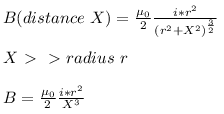
Put appropriate punctuation marks in the following sentences.Sorry to disturb you could I speak to you for a moment Correct answer is 'Sorry to disturb you – could I speak to you for a moment?'. Can you explain this answer?
Put appropriate punctuation marks in the following sentences.
Sorry to disturb you could I speak to you for a moment

|
Gowri Chakraborty answered |
In the sentence "Sorry to disturb you – could I speak to you for a moment?", the appropriate punctuation marks are a hyphen (-) after "disturb you" and a question mark (?) after "moment".
The hyphen is used to join two words together, in this case "disturb" and "you", to form a compound adjective. A compound adjective is an adjective made up of two or more words that describes a noun. In this sentence, the compound adjective "sorry to disturb you" describes the speaker and indicates that they feel apologetic about interrupting the person they are speaking to.
The question mark is used to indicate that the sentence is a question. In this case, the speaker is asking if they can speak to the person for a moment.
Overall, the punctuation in the sentence helps to clarify the meaning and structure of the sentence, making it easier for the reader to understand.
Chapter doubts & questions for Moving Charges and Magnetism - AP Physics 2 2025 is part of Grade 9 exam preparation. The chapters have been prepared according to the Grade 9 exam syllabus. The Chapter doubts & questions, notes, tests & MCQs are made for Grade 9 2025 Exam. Find important definitions, questions, notes, meanings, examples, exercises, MCQs and online tests here.
Chapter doubts & questions of Moving Charges and Magnetism - AP Physics 2 in English & Hindi are available as part of Grade 9 exam.
Download more important topics, notes, lectures and mock test series for Grade 9 Exam by signing up for free.
AP Physics 2
65 videos|83 docs|37 tests
|

Contact Support
Our team is online on weekdays between 10 AM - 7 PM
Typical reply within 3 hours
|
Free Exam Preparation
at your Fingertips!
Access Free Study Material - Test Series, Structured Courses, Free Videos & Study Notes and Prepare for Your Exam With Ease

 Join the 10M+ students on EduRev
Join the 10M+ students on EduRev
|

|
Create your account for free
OR
Forgot Password
OR
Signup to see your scores
go up within 7 days!
Access 1000+ FREE Docs, Videos and Tests
Takes less than 10 seconds to signup









